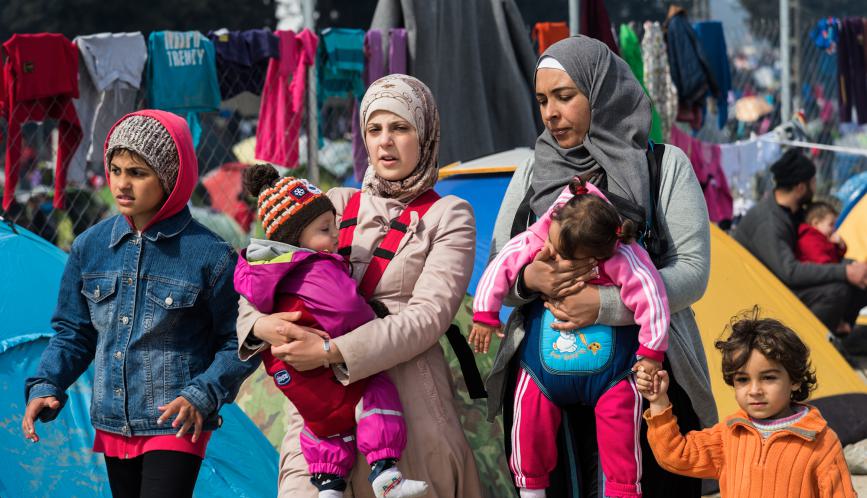There were over 65 million forcibly displaced people in the world by the end of 2015, according to a report by the UN High Commissioner for Refugees (UNHCR). Of that number, signatory states admitted only 107,100 for resettlement. Resettling refugees and other displaced persons is not an easy task. A 2015 report from UNHCR notes that integrating refugees into new communities is a “complex and gradual process comprising distinct legal, economic, social, and cultural dimensions.” Moreover, the processes currently in place are time-consuming; they have yet to evolve to accommodate the elevated levels of need. At the highest volume, more than 200,000 people were entering Europe in a single month during 2015.
Resettling refugees in a quick and efficient way is an issue that is central to the research of Inequality: Measurement, Interpretation, and Policy network members Will Jones and Alexander Teytelboym. Jones, a lecturer in International Relations at Royal Holloway, University of London, has a background in refugee studies. “My research for a very, very long time has been focused on things refugees themselves are interested in doing: what their aims are, what their aspirations are, what their strategies are,” Jones says. He presented on his research at HCEO’s Market Design Perspectives on Inequality conference, which was co-organized by Teytelboym.
Jones and Teytelboym have proposed a solution: a centralized matching system for refugees, similar to what is used in many places for school choice. “In this case, refugees and hosting committees...submit their preferences to a centralized clearinghouse, which can be designed to deliver certain properties,” Jones explains. A matching algorithm is put in place that can factor in a variety of priorities and preferences for both sides. “Governments try to do this stuff, but they often fail because the information is too complicated,” he says.
Their idea has garnered a lot of attention, including articles in The New York Times and The Washington Post. Various government agencies, including several in the US, have approached them about implementing their scheme. Jones notes that the matching system is beneficial to governments. “They can do what they want to do, in a manner that is much cheaper and much faster than the systems that they’re currently trying to use, which often are very unwieldy,” he says. Additionally, resettling refugees in a more efficient way ideally helps them become productive members of their communities much sooner. “The savings to the public purse are enormous,” Jones says.
For now, the academics are focused on disseminating their work, and are collaborating with MIP network member Scott Kominers and David Delacretaz on new research. They have a new website, Refugees’ Say, which features all their work to date. In September, Teytelboym and Jones presented their idea at a migration forum at the Concordia Summit. “There’s a widespread recognition that we need to make our systems run better, that the kind of systems we have right now don’t run fast enough, they don’t get it right often enough, and they are disempowering for both sides,” Jones says.
The matching system is also unique in that it empowers refugees to have a say in their placement in a way that most systems usually don’t allow. “Refugees are often treated as people we do things for. They are not agents in their own right. They’re not in charge of their lives,” Jones says. “This is a way of returning some of that dignity and agency to them, which I think has absolutely got to be part of a kind of a rights-respecting refugee policy.”
Their proposal would not only help place more people, but it would help manage the financial toll that hosting refugees can take on a country. As the UNHCR reports, “developing regions continue to receive refugees disproportionately.” Countries in developing regions hosted 13.9 million refugees by the end of 2015, compared to 2.2 million hosted by countries in developed regions. The report continues: “The Least Developed Countries– those least able to meet the development needs of their own citizens, let alone the humanitarian needs often associated with refugee crises – provided asylum to over 4 million refugees.”
It is crucial for countries with the most resources to fill their allotted spaces, as the current refugee crisis shows little sign of slowing. “We need to make sure these places are fully used up: UNHCR reports that since 2009 every year there were leftover resettlement places that are not used,” Teytelboym says. “This is, of course, unacceptable.” The numbers are daunting. As the researchers note on their website, one million of the 16 million refugees under UNHCR mandate, have resettlement as their only option. And only about 10 percent of those who need resettlement actually obtain it. The U.S., who met its goal of accepting 10,000 Syrian refugees into the country by September of this year, still only resettled about 2 percent of the number of refugees who need a home. As Amnesty International reports, with the exception of Germany and Sweden, EU countries had only pledged around 30,903 resettlement places for Syrian refugees. “We need to improve and modify our resettlement processes to ensure that not only is every place used, but also that every place is used well,” Teytelboym says. “To make sure it's used well, we need to incorporate the preferences of refugees and the priorities and needs of local areas and apply insights from matching theory to find the best matches.”
Thanks to Drs. Will Jones and Alexander Teytelboym for their assistance in completing this article.



